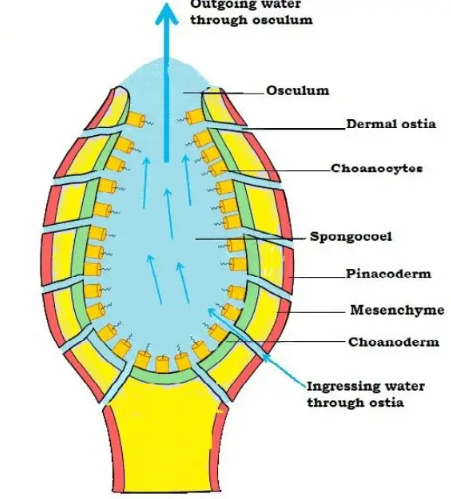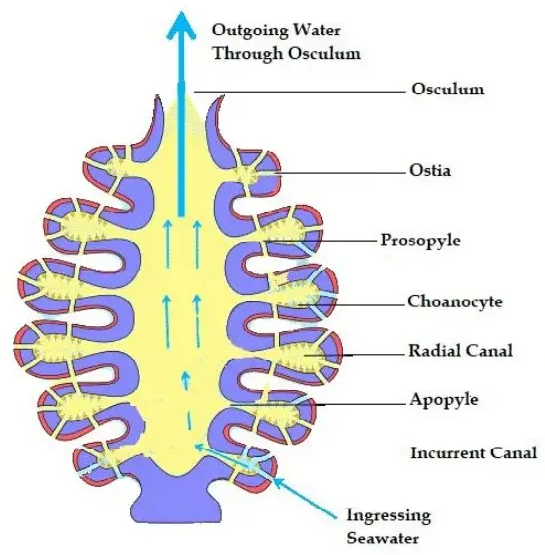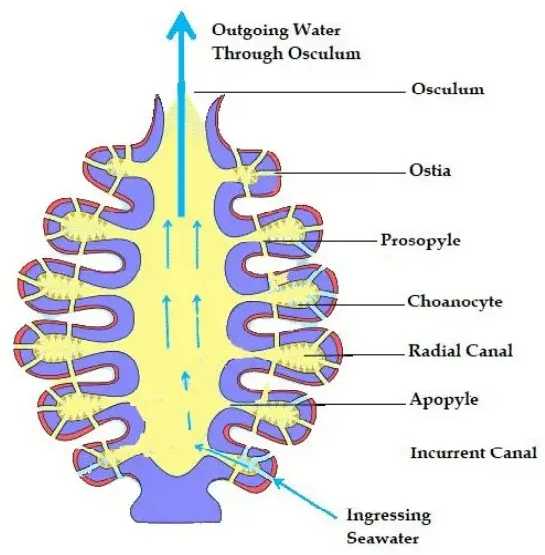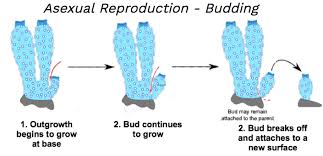Animal Bio Lab 2 - Phylum Porifera - Sponges
1/48
Earn XP
Description and Tags
These flashcards cover vocabulary related to phylum Porifera and fundamental aspects of sponges, including their biology, anatomy, reproduction, and classification.
Name | Mastery | Learn | Test | Matching | Spaced |
|---|
No study sessions yet.
49 Terms
Phylum Porifera
A phylum consisting of simple multicellular animals known as sponges. means “pore bearers”
Protozoans = unicellular animals
Metazoans = multicellular animals
“Zoans” ~ animals
Metazoans vs Protozoans
Cellular grade of organization
(basically loose aggregations of cells with little or no tissue organization; division of labor among cells, but no organs, systems, mouth, digestive tract, and only primitive nervous integration)
What grade of organization do sponges exhibit?
-among the simplest metazoans
-cellular grade of organization
-no germ layers
-sessile adult forms
-some asymmetric, some have radial symmetry
-some solitary, some colonial
-pore bearing
-canal systems
-internal skeletons of spicules or spongin
-flagellated choanocytes
-spongocoel (internal cavity that opens to outside)
-osculum (opening to the outside)
-most marine, some freshwater
General Features of sponges
Sessile
Referring to organisms that are fixed in one place and do not move.
Pores
Small openings in sponges that allow water to enter.
Choanocytes
Flagellated cells in sponges that create water currents and capture food. “collar cells”
Spicules
Skeletal structures found in sponges that provide support, often made of silica or calcium carbonate.
Collagen fibers
Proteins that constitute the sponge's internal skeleton, known as spongin.
Spongocoel
The internal cavity of a sponge through which water circulates.
Osculum
The large opening of the spongocoel in sponges through which water exits.

Asconoids
category of sponges that have flagellated spongocoels; the simplest sponge canal system with a large central cavity (spongocoel) lined with choanocytes. Water exits via osculum

Syconoids
category of sponges that have flagellated canals; A sponge canal system with flagellated canals that lead into the central cavity (spongocoel). Water exits via osculum

Leuconoids (most sponges)
category of sponges that have flagellated chambers; The most complex sponge canal system with clusters of flagellated chambers that draw water in from incurrent canals. Water flows out excurrent canals that converge to form an osculum. In large sponges, there may be many oscula.
Class Calcispongiae
Class of sponges with calcium carbonate spicules.
Class Hexactinellida
Class known as glass sponges that exhibit six-rayed siliceous spicules.
Class Demospongiae
Class of sponges characterized by siliceous spicules or spongin or both but no six-rayed.
Class Homoscleromorpha
Class of encrusting sponges called “coralline sponges” with simple or no spicules.
-marine, living in clusters in shallow water
-vase-shaped with bristled appearance due to spicules
-body wall = system of tiny, interconnected dead-end canals lined with choanocytes that draw in water through pores, remove needed food and O2
-water empties into spongocoel (lg central cavity) and exit through osculum
-monoecious, producing eggs and sperm in the mesohyl
-fertilized eggs develop into free-swimming, blastula-like embryos called amphiblastula larvae that break through the radial canals and leave via osculum, settle on substrate and grow into sessile adults
-reproduce asexually by budding off new individuals from their base
Features of Scypha, a syconoid sponge

dermal ostia → incurrent canals → prosopyles (pores in body wall) → radial canals → internal ostia (apopyles) → spongocoel → osculum → out
Trace the flow of water into and out of Scypha sponge
Kingdom Animalia
Phylum Porifera
Class Calcispongiae
Genus Scypha
Classification of Scypha
Amphiblastula larvae
Free-swimming larvae produced by Scypha during sexual reproduction; often found in the radial canals.
Parenchymula larva
A type of larva formed by some sponges, including most Demospongiae, in which the flagellated cells invaginate to form a solid internal mass.

Budding
An asexual reproduction method in sponges where new individuals grow from the base.
Gemmules
Survival structures produced by freshwater sponges and some Demospongiae, to endure harsh conditions; made of clusters of archaeocytes;
Freshwater gemmules are enclosed in hard shells and develop into young sponges in spring; Marine gemmules give rise to flagellated larvae.
Archaeocytes
Wandering cells in sponges that can differentiate into other cell types like sclerocytes, collenocytes, and gametocytes.
Pinacocytes
Thin covering cells that line the outer surface and incurrent canals of sponges.
Mesohyl
The jelly-like matrix in the wall between the pinacocytes and choanocytes in sponges.
Prosopyles
Pores that connect incurrent canals to radial canals.
Apopyles
Internal ostia or openings from radial canals into the spongocoel.
Sclerocytes
Cells in sponges that produce spicules.
Collenocytes
Cells that secrete collagen in sponges.
Gametocytes
sex cells
Filter feeding
Method by which sponges obtain food by filtering water.
Symbiosis
A mutually beneficial relationship, as seen between sponges and certain microorganisms.
Dermal ostia
External openings through which water enters the sponge.
Radial canals
Canals in sponges that are lined with choanocytes and connect the spongocoel to the outside.
Excurrent canals
Canals that carry water out of the sponge.
Incurrent canals
Canals that draw water into the sponge.
Holdfast
The part at the base of a sponge that anchors it to a substrate.
Bristled surface
The appearance of sponge surface due to protruding spicules.
Cluster
A group or colony of sponges growing together.

straight or curved monaxons (single, pointed at both ends)
triaxons
triradiates (Y-shaped)
tetraxons (six-rayed)
polyaxons (T-shaped)
spongin - fibrous
Types of spicules
Siliceous spicules
Spicule types made of silica, commonly found in Demospongiae.
Calcareous spicules
Spicule types made of calcium carbonate, typically found in Calcispongiae.
Spongin
A tough, fibrous protein that forms the skeleton of some sponges.
Substrate
The surface or material on or from which an organism is growing or feeding.
Hydrostatic skeleton
Support system where the pressure of fluid within the cells gives shape to the sponge.